Crawling Back: Amazing Spider-Man Annual #1 Review
Despite some recently revealed narrative issues, this annual remains a nostalgic, nerdy favorite that forms the foundation for my comic book collection
—by Nathan on February 26, 2022—
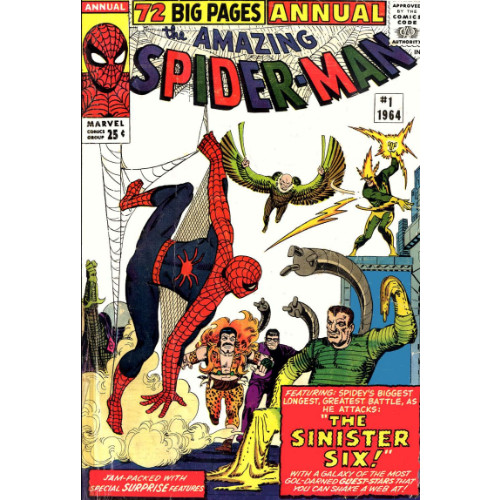
This review is nearly 18 years in the making.
While vacationing in Florida in 2004, my family visited a bookstore–in my mind, it’s a Borders, but it could easily have been a Barnes & Noble. My dad, on the plane trip down, had produced a digest-sized volume from Marvel’s Marvel Ages imprint, a line of comics which retold classic Silver Age stories for younger readers. He’d gifted me the first volume in the Spider-Man line, which retold Amazing Spider-Man #2-5. Though I remember receiving the volume, my memories of reading it for the first time are hazy. Was I immediately hooked by the hero? Was I enthralled or confused by the characters I was introduced to–Sandman, Doctor Doom, Betty Brant? I don’t recall my reactions.
I do remember that visit to the bookstore, however. My dad allowed me one purchase, and for a while, I stood a torn child, deliberating between the first and second volumes of Spidey’s Marvel Masterworks line. Even now I remember the mental debate: that first volume contained the inaugural issues of Spidey’s history, foundational stepping stones including his origin in Amazing Fantasy #15 and the first several issues of Amazing Spider-Man…
But the second volume contained the first annual.
I knew very little of Spidey’s history at the time, my knowledge limited to Sam Raimi’s first Spider-Man film and a Spider-Man: The Ultimate Guide book by Tom DeFalco (famed Spidey scribe in his own right). I was a little familiar with Spidey’s origin and certain story arcs–“Kraven’s Last Hunt,” the infamous “Clone Saga,” the birth of Venom–and knew a bit about the villains. But even at nine, with very little actual comic book experience under my belt, I understood the peculiarity of Spidey’s powerful rogues gallery. Colorful, classic connivers, criminals, and cretins who’d cause our crawling comrade conniptions. So when I saw six–yes, six–such adversaries packed into the annual’s cover, a few of whom I was already familiar with (Doctor Octopus, Vulture, Sandman), my young self felt, appropriately enough, amazed.
I selected the second volume. And I’ve read that first annual so many times since, the pages are falling out of the book.
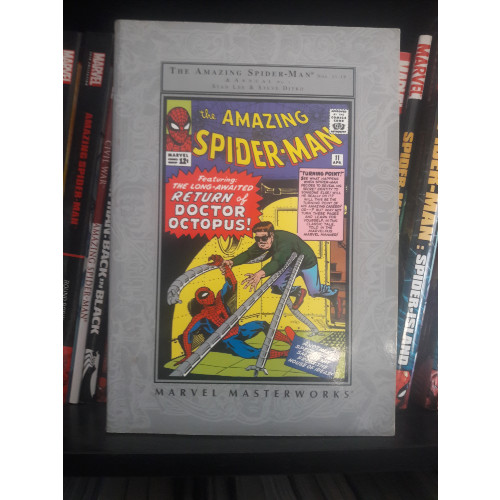
This is “Crawling Back.” It’s the third series I’ve embarked on in the last few years as I’ve churned out content for this blog. The two other series each tackle specific subject matter–as I outlined in my introductory post, “Spider-view” analyzes Spider-Man comics in a chronological fashion, from the 80s onward; and as I discussed in my first “(Strand)om Stories” post, the second series reviews volumes which collect stories from other corners of the Marvel Universe, tethered in some way to my “Spider-view” posts (for example, a recent collection I reviewed containing Nick Spencer’s run on Astonishing Ant-Man was published shortly after I examined a series of Spidey annuals that starred Scott Lang’s diminutive alter ego). “(Strand)om” has in some instances taken on a life of its own–a few posts on different Daredevil, Black Panther, or X-Men volumes spin out of each other rather than being connected to a Spidey story every time–but each initial post is tethered to a Spider-Man narrative in some way.
Naturally, eager, inquisitive me eventually wondered, What about the Spidey stories which came before where I started in the 80s? What about issues which I may wish to discuss which will never crop up chronologically? This annual, specifically, is an issue I had in mind. Though I mentioned the tale briefly in a Hubpages post a while back, I have never given this annual the treatment I believe it deserves, highly regarded as it is in my mind. Amazing Spider-Man Annual #1 is my single favorite issue in Spidey history and remains the blessed entryway into those Silver Age narratives. As I recently reviewed David Michelinie and Erik Larsen’s six-part revival of the team in 1990’s Amazing Spider-Man #334-339, I felt it appropriate to take on the Sinister Six’s original appearance here.
A long-winded intro, but I hope you’ll forgive me and allow me time to remark upon why this issue solidly remains my favorite issue of all time.
“The Sinister Six”
Writer: Stan Lee
Penciler: Steve Ditko
Issue: Amazing Spider-Man Annual #1
Publication Date: October 1964
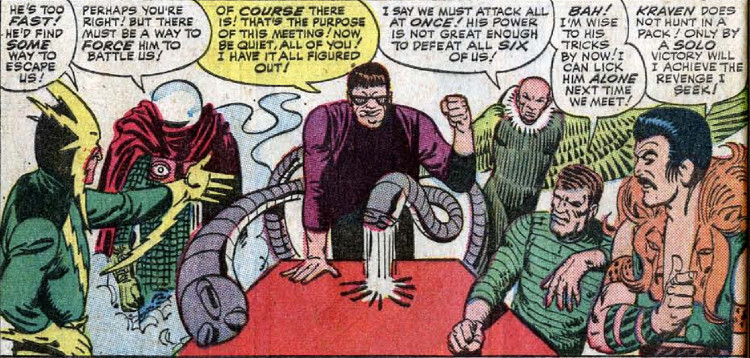
A little over two years after Spidey debuted in Amazing Fantasy #15, Stan Lee and Steve Ditko (who had written and illustrated the hero’s adventures up until that point and would continue on together until Amazing Spider-Man #38) crafted this standalone annual. It was the first time in the hero’s brief history that several of his foes had formed an official team (aside from a rather unofficial team up between the Green Goblin and the Enforcers), and despite their nearly three-decade hiatus between their first and second appearances, the Sinister Six remains a wonderfully influential aspect of Spidey’s history. Look at their appearances since, or look at Sony’s difficulty in teasing and pulling together a Sinister Six movie during the Amazing Spider-Man era. The closest we’ve gotten to a film version of the team was in Spider-Man: No Way Home, and even then, the assembled villains (Doc Ock, the Green Goblin, the Lizard, Electro, and Sandman) only made up 83% of a true Sinister Six roster and didn’t really coalesce into a fearsome fighting force.
The team’s wonderful longevity can be traced back to a surprisingly simple plot by Lee and Ditko. Doc Ock, breaking free from prison, assembles the five other foes, who have each tested their mettle against the Web-Head and subsequently lost. Lee and Ditko’s decision to include these particular villains feels perfect; from a historical standpoint, it’s not a matter I’ve considered much beyond “Yeah, those guys were the Sinister Six,” but once I started leafing through other potential candidates, Lee and Ditko’s choices were clear. The Lizard had been cured by Spidey and had not reverted to his scaly alter ego since; the Green Goblin was too much of a wild card, and Lee and Ditko seemed more interested in the mystery behind his identity than anything else; the Chameleon was a plotter and schemer and seemed less likely to take on Spidey head-on.
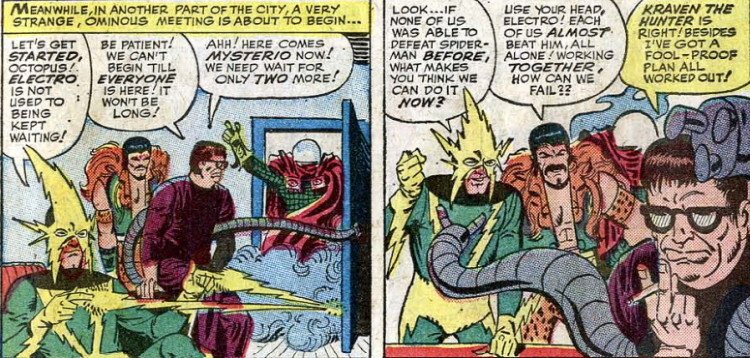
Spidey had bested each of the assembled villains in armed combat previously. Doc Ock and Vulture had been trounced twice each (technically, Spidey had faced Doc Ock on three occasions, but brouhaha #2 seemed inconclusive and occurred shortly before fight #3 so I’m lumping those two together…sorry, dorky comic book details); the others (Mysterio, Sandman, Electro, and Kraven) had each faced their comeuppance once before. “Revenge” is a simple enough concept for Lee to toy with, yet one which works surprisingly well. Michelinie’s saga involved Ock using various lures, threats, and promises to pull together his former allies; Lee’s version is straightforward–these guys hate Spider-Man, so why don’t they do something about it?
There’s something remarkably simple yet effective by having Ock just bring a group of thugs together to bash in our Spider-buddy’s head. Perhaps it’s the nostalgia talking, but the sight of these six supervillains assembled in a room–most of whom wear decidedly verdant costumes, creating a unique color theme amongst the group–brings chills every time I read the scene. The importance lies not so much in the reason why they assemble or the simplicity of the plot. A sense of history hits me whenever I read this issue. The concept–grouping together six insidious supervillains who all hate Spider-Man–is born right here, for the first time. And who better than Otto Octavius to pull their strings? Heck, he doesn't even need his tentacles to do any of the tugging.
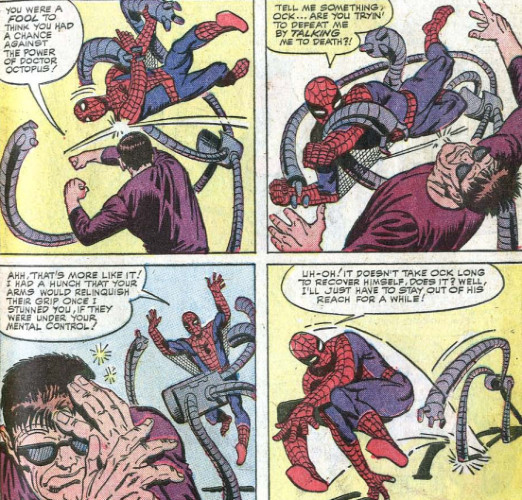
Yes, a lot of my love for the story may be nostalgia, but some of it may be the fact that I assign a certain amount of historical weight to each of the villains assembled here. Knowing what I know about these crooks and their histories–such as Kraven’s “final” fight with Spidey, Ock’s role in Captain Stacy’s death, Mysterio’s role in Kevin Smith’s excellent “Daredevil: Guardian Devil”–may heighten the impact of this issue. When I see Sandman, I don’t just see the guy who got sucked into a vacuum during his first fight with Spider-Man; I see his history in the comics, I see a dozen fights between him and Spidey. Same with everyone else. It’s like looking at a photo album and seeing your younger self or the younger self of a sibling; who you were then, who they were in those earlier years, is framed through the individuals you or they currently are.
The plot itself, simple as it is, mostly works. Lee and Ditko have the Six kidnap Betty Brant–whom Ock knows from experience Spidey has rescued before–along with, completely incidentally, May Parker. Tension is mounted quickly as Peter is forced to battle to save the lives of two women he loves more than anything. Lee, generally, seems too enamored with the ensuing escapades against the Sinister Six to spend a ton of time on having Spidey worry over their safety, which I think is an element I would have appreciated seeing more frequently. A few moments see Peter express concern, but once the action kicks in, it's all fisticuffs from then on.
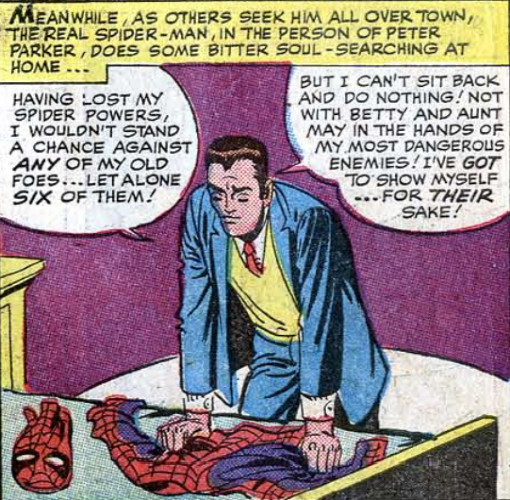
Lee writes Betty and May’s hostage situation humorously–Betty fully understands the danger, but May is too charmed by Ock’s seeming kindness to worry. Her comments on Ock’s multi-limbed condition, as well as her concern about being rude to their host, smacks as amusingly ridiculous. It’s a “Stockholm syndrome” of sorts, but Lee plays up the goofiness of the notion rather than the sheer terror such a concept might create (the idea, entertainingly, would return in future years–one nutty tale by Gerry Conway, as I referenced recently, would see May almost become Mrs. Octavius.). Is it realistic? Not a whit, but similar to my perception of the Six, I don't find May's attitude distracting. Perhaps if more recent writers used the same idea, I'd be bothered. But here, Lee establishes a trait he'd lean on more heavily in future stories.
Lee later juxtaposes May’s enamored view of her and Betty’s mollusk-monikered “host” with her startled reaction the first time she sees Spidey. Why such a horrible man would need to go around masked, she doesn’t know…but she doesn’t trust him. The conflict is palpable, heightened by the inescapable irony both Spidey and the audience realize: May is more comfortable with a sinister stranger than the heroic adventurer who is secretly her nephew. This is, I think, why I let Lee's characterization slide. Undoubtedly unrealistic as it is, Lee uses May's seemingly senile but certainly silly judgments to craft this unique, unspoken conflict between the two. It's like Spidey's long-running belief that him revealing his dual identity to his aunt would send her into a shock, possibly kill her. Would the revelation harm her? Possibly not. Would Aunt May really be so trusting of the guy with the metal arms whose costumed compatriots bustled her off the sidewalk into a taxi? Hopefully not, from a realistic standpoint. The characterization is, I think, intentionally exaggerated.

J. Jonah Jameson also lays claim to subplot territory; his consistent attempts to get ahold of Spider-Man at the behest of the Vulture leads him to talking to actual spiders (he reasons that if Ant-Man can talk to ants, Spidey should be able to communicate with arachnids) and worrying his staff. Lee writes his dialogue well, casting him in the common mold of the tight-fisted publisher who’s too much of a narrow-minded skinflint for his own good. Similar to the scenes with Betty and May, Jonah’s involvement is more comedic than anything else–realizing he’s scooped on Spidey’s recent antics while abrasively arguing with arachnids, JJJ flies into despair, barely recognizing the fact his secretary has been kidnapped (a notion amusingly heightened near the story’s end, where Betty remarks she should be returning to the Bugle–surely, Jameson is worried sick about her whereabouts!). More exaggeration? Certainly, but amusing nonetheless.
Funnily, the two teenagers, Betty and Peter, prove the voices of reason through the tale, balancing out their elders’ bizarre behaviors. Similar to the plot, however, I find Lee’s characters charming–again, like his villains, he imbues May and Jonah (and, to a lesser extent, Betty) with characteristics (May’s obliviousness, Jonah’s bristly nature) they’ll largely retain during their decades of history.
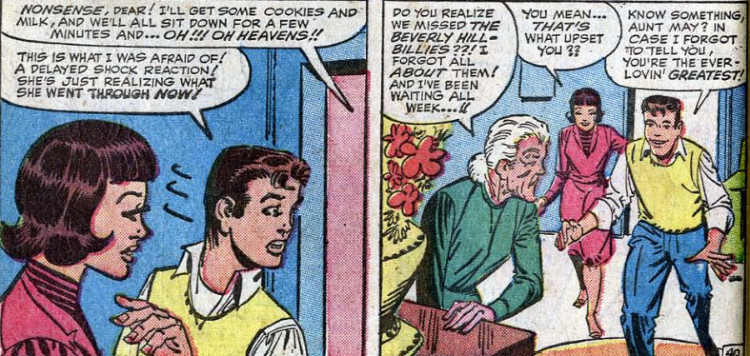
Where the plot and characters don’t work as well is where Ock executes his plan. He sends each of the Sinister Six to a location best suited to their abilities and skills, has May and Betty kidnapped, and draws Spidey out to do battle with each of the terrible team members. I’ve never quite understood why Lee allows Spidey this advantage (facing each of his adversaries rather than the whole group at once) other than for the narrative to work in Spidey’s favor. To their credit, Lee and Ditko throw in a subplot where Spidey temporarily loses his powers, momentarily heightening the danger and tension; even this, however, is negated as soon as Spidey encounters his first foe, Electro, removing most of the tension built up. Full-powered Spidey is allowed to work his way through each villain.
Despite the relative weakness of Ock’s plot, the mano-a-mano combat gives Steve Ditko the opportunity to craft glorious splash pages, freeze-framing each battle in a single, spectacular moment. Whether it’s Spidey crashing through a hidden window and decking Mysterio in the fishbowl, tangling with the Sandman as the villain tries engulfing our hero with his literal beach bod, or calling “Lights out!” on Electro with a shot to the kisser, each moment is gorgeous; the assembled images remain, to this day, one of my strongest memories regarding the entire issue. Erik Larsen did his best to echo Ditko’s pages for his and Michelinie’s saga, and though I prefer these original images more, Larsen should be given credit for creatively copying the concept rather than straight-up mirroring the images themselves. If Marvel made posters for each of these conflicts, I’d snatch ‘em up for sure.
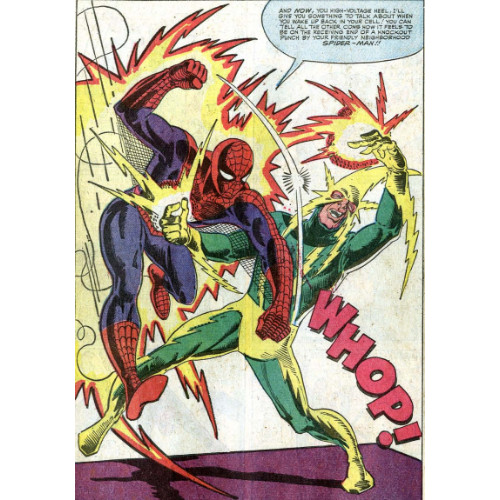
Can the issue feel a little old at times, a little simple and coincidental at moments? Sure, but this is Silver Age stuff we’re talkin’ about here! The somewhat random, non-sensencial shenanigans Lee and Ditko weave together happened all the time. Perhaps it strains the reader’s well-meaning credulity, but the narrative is highly entertaining regardless. Even reading the issue for this review, for the first time in however many years, I felt a pulse of gleeful wonder skip through me. Nowhere does the writing feel as verbose as some of Lee’s other narratives, the characters all feel fully-realized, the fights are still iconic, and Ditko’s images captivate throughout. I know a lot of my love for this annual can be found in its historical importance in my personal comic reading journey, but as a standalone story, the Sinister Six’s first appearances remains as classically wonderful as when I first laid eyes on the cover.
I'm not sure how often I intend on covering older, classic stories such as these. I certainly don't think "Crawling Back" will become as prominently featured as "Spider-view" or "(Strand)om Stories." Still, here and there, I hope inspiration strikes–I hope some story I'm reviewing causes me to flash back to these older tales, gives me reason to tap out a few words about some memorable Spidey narratives. I've got plenty to cover. Amazing Fantasy #15, the death of Gwen Stacy, the Green Goblin revealed as Norman Osborn, and more. As time marches on, and as I continue churning out content, we'll see how the future reflects upon the past.